Living with dogs, particularly a new puppy, teaches you rapidly how quickly your house becomes one giant chew toy and how much, uh, mess (don’t judge) is left in every room. A inquisitive dog won’t take long to find socks and rubbish beneath the couch—oh, and look at all those interesting cords plugged in all over the place! A veritable gold mine for our dogs, who also happen to be highly dangerous.
Your house has additional opportunities to dog-proof each room. There are some unexpected dangers everywhere, from the living room and bedroom to the kitchen and laundry area. However, be at ease! Making small changes to your furnishings and décor can provide your dog plenty of comfortable space to unwind in.
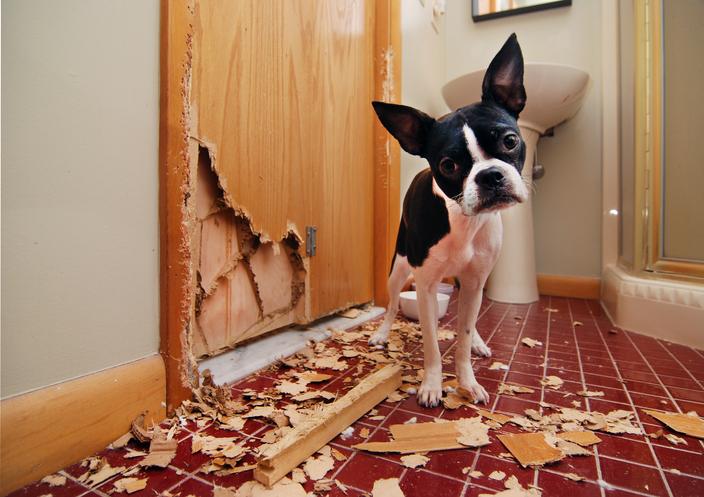
Dogs are fluffy danger vacuums on four legs because they use their noses and mouths to explore their surroundings. You are more likely to see things that could unintentionally endanger your best buddy, a dog, if you literally consider things from their perspective.
I always advise considering your dog’s perspective when assessing a room in your house for safety; what is their height and where is their line of sight? You can find dangerous items that might catch your dog’s attention by evaluating your house from their height. You may be shocked to learn that your golden retriever can easily take your brand-new watch since it is perched just right on your bedside table. Little things that are easily accessible should be taken out and stored in secure places where your dog cannot get to them, like closets or drawers.
Your end table, your bed, and your rocking rocker. If your dog is a good climber and can jump up on things quickly, you might want to remove any potentially dangerous furnishings. Jump-activated chairs have the potential to hurt your dog as well as injury other objects in your house when they swing back. Dogs who follow their noses and will put their paws up on furniture might quickly become distracted by end tables with glass picture frames or breakable family treasures.
Does your dog enjoy a nice, cozy couch spot? Is he more comfortable curled up on a blanket? Dog proofing your house requires careful consideration of where those things should be placed. Never put blankets, dog beds, or rugs next to heaters, fireplaces, fans, or electrical cords or outlets since they can easily become harmful.
The kitchen, bathroom, and laundry rooms are typically the riskiest rooms in your house, but you should spend time in every room since they can all be dangerous. To help divide up spaces or keep your dog out of areas you don’t want them to enter, get some strong baby gates. Your dog will have lots of wonderful spots to rest and unwind once you’ve made these sections of your house safe.
There are a lot of things in kitchens that aren’t dog friendly, like food, medicine, and cleaning materials. Your dog has the greatest opportunity to discover and eat objects that are not appropriate for them. However, kitchens may make excellent doggie hangouts once they are dog-proofed.
Electrical cords, fireplaces, open windows, and recliner chairs are the most frequent issues in living rooms. Since your dog will probably spend the most time in this room with you, it is crucial to make sure it is secure for them.
A dog’s favorite spot to search for intriguing treats to sample and entertaining “toys” to try is usually the bathroom. The greatest method to exercise effective management is to keep cabinets closed, and even better, to keep the bathroom door closed.
Dogs are frequently kept in protected places like bedrooms. Make sure to take out anything that could choke your dog and don’t leave anything out that you’d prefer not to become a chew toy before using your bedroom as a place for them to unwind.
Curious dogs might encounter numerous hazards in laundry facilities. While some risks are more overt, others are more covert. When in doubt, keep the washing room off-limits.
Dogs should never be left unattended outside, but if you do allow your dog to go outside for bathroom breaks through a doggie door in the backyard, make sure the area is secure and safe. Dogs that are bored can easily escape through holes, loose posts, and unlatched gates; therefore, it is important to supervise them whenever they are near pools or play equipment.
Our dogs quickly locate comfortable places in any home and are excellent adapters when we assist them in doing so in a secure manner. For the sake of your dog and to make sure they are comfortable and safe when you are not there, make sure your home is dog-safe.
If you are interested in a Posh Dog Knee Brace contact us via our contact form or visit our Facebook Page.
Pets that support you emotionally and enhance your health are called therapy dogs. To help both yourself and other people, you can teach your dog to be a therapy dog.
Dogs used for therapy reside in homes. They can also visit a range of locations, such as schools, hospice homes, hospitals, retirement or assisted living facilities, and schools. They have been educated to tolerate being petted or hugged by strangers and to be kind and amiable. When kids pull at their fur or when grownups want the younger ones to sit on their laps, they are understanding and unfazed.
One kind of therapy animal is the therapy dog. Additional animals that can provide emotional support include horses, llamas, alpacas, cats, bunnies, and birds.
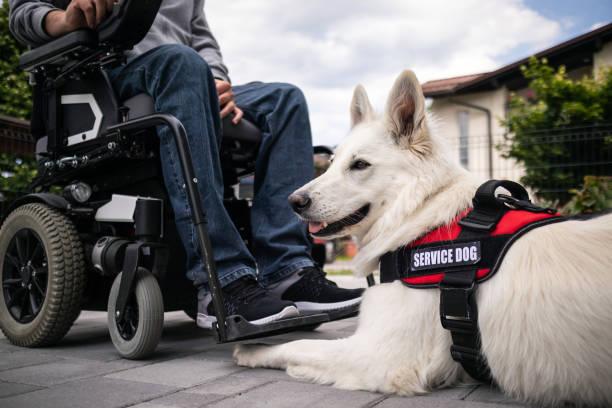
Although they’re not the same as therapy dogs, service dogs are something else entirely.
*The ADA does not protect therapy dogs, sometimes known as emotional support animals.
Service Animals and Emotional Support Animals, ADA National Network, 2014. They therefore lack the same rights as their owners to join them in restricted public areas unless prior authorization is granted. To offer some constructive comfort treatment, the therapy pet needs to be welcomed onto the property.
It is commonly recognized that therapy dogs can help with a variety of mental health issues and psychiatric problems.Interaction with therapy dogs and other companion animals is beneficial for patients with a variety of diagnoses, including depression, bipolar disorder, autism, ADHD, post-traumatic stress disorder (PTSD), and Alzheimer’s disease.
Therapy dogs can also assist with physical health issues that may be the cause of emotional difficulties. Empirical evidence indicates that individuals undergoing animal-assisted therapy may experience reduced pain during their convalescence following challenging surgery or a severe accident. According to studies, these connections can lower the stress hormone cortisol and raise the hormone that improves mood, oxytocin.
With a little instruction, any amiable breed of dog can become a therapy dog. Larger breeds are frequently utilized as therapy dogs, including Labradors, St. Bernards, standard poodles, and golden retrievers. On the other hand, when the patient and the dog are sharing a confined space, smaller breeds like Pomeranians and micro poodles make sense.
Although the breed may have some influence on the dog’s pleasant nature, the dog’s upbringing and even temperament development play a major role. Dogs are evaluated and studied for how they react to various stimuli, including unexpected grabs, loud or confusing noises, and even equipment like wheelchairs or canes, before they are approved as therapy animals.
Many internet directories are available if you would want additional information about how to find a therapy dog to aid you or a loved one. To identify people and organizations in your area, search for “therapy dog” along with the name of your town or city online.
Do an internet search for “therapy dog training” along with the name of your town or city to find out what options are available if you’re interested in finding out more about training your dog to be a therapy dog or visiting nursing homes or other facilities with your pet. Or just contact the facility of your choice by phone or email to find out about their admission policy.
For more information about therapy or our Posh Dog Knee Brace you can contact us via our contact form or Facebook Page.
One of the key causes of dogs’ passion of chasing other animals is their prey drive. Our veterinarians can offer guidance on prey drive and safe ways to handle your dog.
For many dogs, prey drive is an instinctive behavior. Unfortunately, prey drive can occasionally result in issues, mishaps, or damage to your dog or other animals.
If your canine companion is constantly chasing squirrels or sprinting after birds when you go for walks, check out our tips on prey drive and how to keep your dog safe.
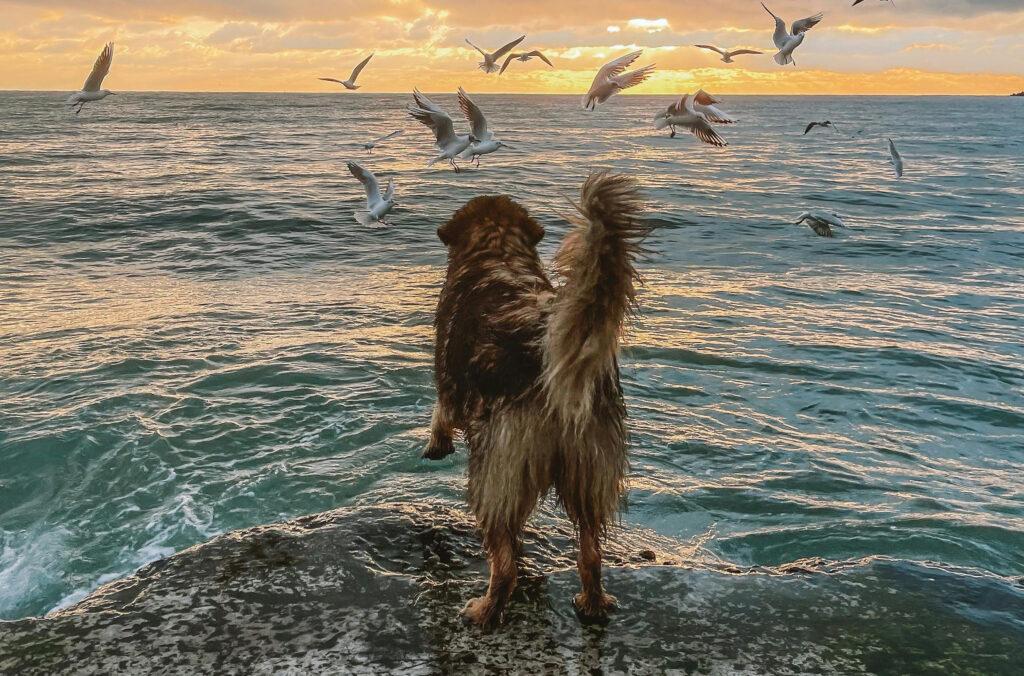
Animals with a prey drive have a hunting urge that enables them to capture food. When many dogs play, such chasing a ball, tugging games, or ripping up plush toys, you may have witnessed this. We may provide them with a secure outlet for their prey drive by encouraging these behaviors in them.
Some canines are more troubled by prey drive than others. “My dog has a high prey drive” refers to a person’s dog’s propensity to chase and catch animals such as mice, squirrels, or farm animals.
Breeds including Greyhounds, Lurchers, Collies, and Terriers are frequently known to have high prey drives. But any breed of dog can exhibit high prey drive, so it’s critical to recognize the warning signs and provide your dog with training to help curb their chasing tendency.
When near animals, exercise strict control over canines. Allowing your dog to harm or kill a farm animal is illegal, and both you and your dog may face harsh consequences. In the event that your dog is uncomfortable among sheep or other animals, you can:
In the event that your dog escapes the leash or that a farm animal pursues you:
If you are interested in more information about our Posh Dog Knee Brace you can send us a message via our contact page or visit our Facebook Page.
Does your dog receive a meal before you leave for the day but hold off on eating it until you come home? That indicates he is a little (or a lot) anxious about being left alone at home.
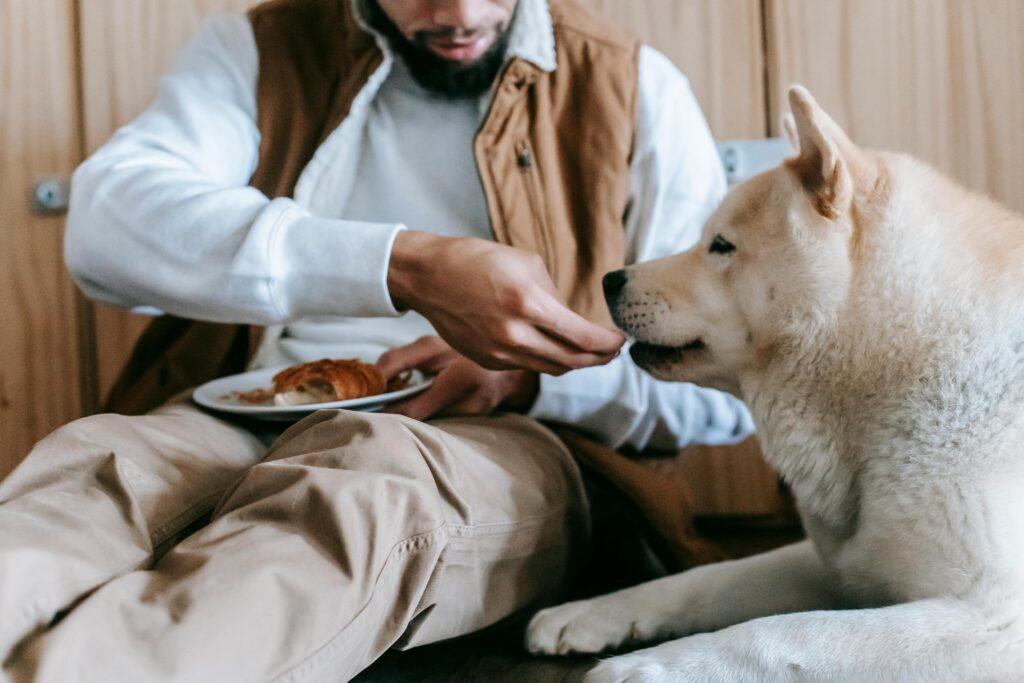
Unexpectedly many dogs refuse to eat meals while their owners aren’t home, but they scramble to finish their meals as soon as their loved ones get home. The most frequent cause of your dog’s lack of appetite while you are away is worry, and a worried dog is a cause for concern.
“But my dog doesn’t seem stressed,” you might object. If your dog only exhibits stressful behavior when left alone and her stress level is low enough that she isn’t acting out in other ways, it’s possible that you aren’t present when she exhibits her primary stress behavior, which is refusing to eat when you aren’t around.
Dog training experts frequently advise clients to leave their dogs with a slow-feeding dog toy, such as a stuffed Kong, to keep them occupied and relieve stress while their owners are away. You can’t use this useful enrichment tool if your dog won’t eat while you’re gone. And when your dog is too anxious to eat meals, it is never a good thing!
Check to see whether he/she will eat if there is another person around first. You’ll be able to discern from this if she is experiencing low-level separation stress (she must be with you) or isolation stress (he/she is fine around any person as long as she is not alone). If he/she exhibits any additional signs of anxiety, such as pacing, panting, or vocalizing, put up a cell phone, laptop camera, or security camera to record footage of her while you’re away.
His/Her anxiety is probably not too severe if there are no other indicators of stress, and you might be able to relieve his/her with an over-the-counter supplement like L-theanine (consult with your veterinarian first!).
If he/she is more distressed, you are dealing with a problem that is more serious than mild stress or anorexia. If that’s the case, I advise you to seek the help of an experienced force-free professional. These individuals would have the initials “CSAT” (for certified separation anxiety trainer, certified by separation anxiety specialist Malena DeMartini) or “SAPro” (for a “Separation Anxiety Pro” trainer, certified by Julie Naismith) and be qualified to work with separation anxiety.
Keep in mind that if your dog is stressed, help is necessary.
If you are interested in a Posh Dog Knee Brace contact us via our contact form or visit our Facebook Page.
The health of the dog depends on the owner’s ability to slow the dog’s eating.
Most dogs enjoy eating. Some dogs seem to devour their meal faster than we can blink since they adore it so much! Dogs who consume food too quickly may get sick, especially if they also take in a lot of air and develop the potentially lethal illness known as bloat. Anyone who has had their dog go through this disease understands how crucial it is to train them to eat more slowly.
Some dogs consume food so quickly that their systems can’t keep up with it; the food never even reaches the point of digestion. The end consequence is food regurgitation, which happens when food is ingested and then immediately comes back out of the mouth as a result of the esophagus’ muscles contracting backward. Food was never even consumed by the stomach. In these situations, it is advised to reduce the dog’s food intake.
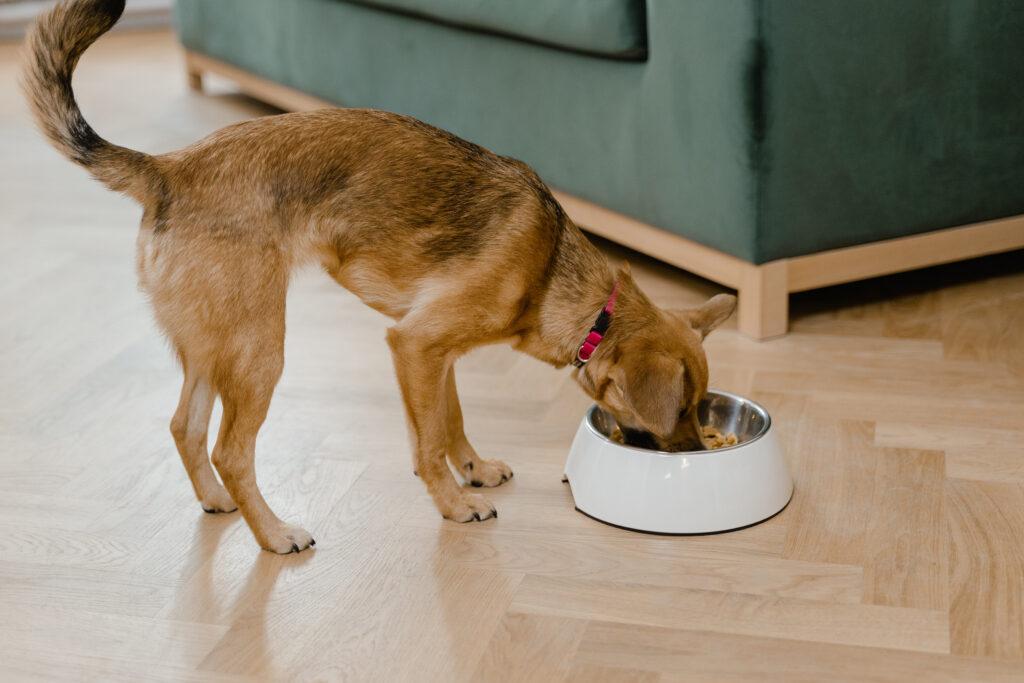
Consult your dog’s veterinarian if you’ve tried these remedies and your dog is still vomiting or regurgitating food to rule out a more serious problem.
You can always reach us on our contact page or check out our Facebook Page for information on our brace and more.
Hi everyone! Today I would like to talk about dog behavior!
This is Kristi. I’m one of the veterinary technicians with Posh Dog Knee Brace.
Today I want to talk a little bit about what we have been seeing over the last year or so. We all know how covid put a damper on EVERYTHING and so it seemed one bit of happiness was getting a new dog or puppy. Remember how shelters across the country were saying “we’ve adopted out all our animals!” Yay! We have homes for them!
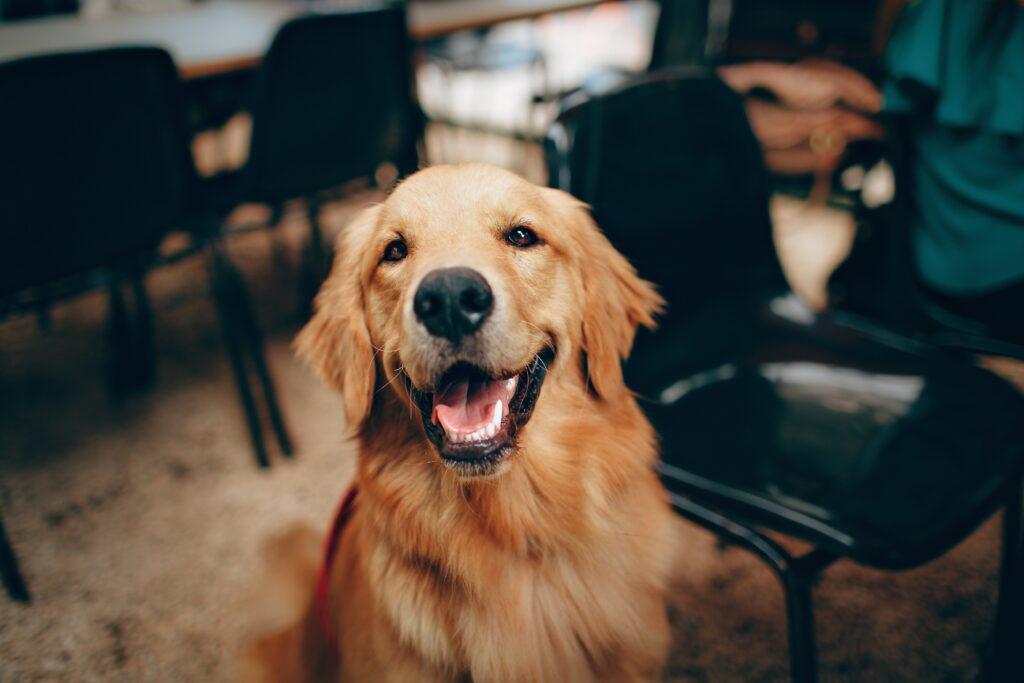
On the flip side of things, these animals were being brought into homes were everyone in the family was home 24/7 and so being left alone or being socialized with other animals and people didn’t happen. Let’s fast forward to when things started to get back to normal. Our dog has been with his family for the better part of a year and now all of a sudden no one is home with them. This has created a lot of separation and social anxiety for these dogs.
It’s really important to do your research and assess your living situation before getting an animal, especially dogs. Dogs a very social animals and they need to be able to interact properly with their families but also with other people and other animals as well. Puppy classes or training classes in general are highly recommend at any point in a dog’s life but especially new puppies and adopted dogs.
Everyone can teach their dog to sit and stay but what about reacting to other dogs on a leash or feeling comfortable with touch? Petting their head, a little bit is not the same as trimming nails or cleaning ears, letting a veterinarian look for areas that hurt. Taking them to classes or using a behaviorist can help immensely with these problems.
Maybe you are reading this and thinking, “that’s my dog, but he’s older than a puppy.” It’s not too late for them. You will have to put time and effort into their training and I highly recommend a behaviorist if you dog is really nervous or has behaviors you don’t like but things can change for the better. You just have to be willing to work with them and be patient with them. This will take time and consistency but learning your dog’s language will help you learn how to communicate with your dog in a positive way.
I like to use myself as an example. I have grown up with dachshunds (wiener dogs) my whole life and I have an old guy now. If anyone doesn’t know a doxy’s personality, let me tell you they are a big dog in a small dog package. They can be loud and love to bark at anything! When I was doing classes with my girl, one thing I asked the trainer was how do I get her to stop barking when someone comes over? I’m yelling at her to stop and she keeps going for 5 -10 minutes.
The trainer said, she doesn’t understand English, she understands emotions. When you are yelling and giving her attention, you are basically saying to her “THERE’S SOMEONE HERE, WE NEED TO BARK!” And she is thinking “THERE’S SOMEONE HERE, YOU ARE BARKING TOO, LETS ALL BARK TOGETHER. YAY, THIS SO MUCH FUN!” I thought hmmm…ok so what should I do? Ignore her. What? Ignore her. It will take some time but if you pretend, she doesn’t exist, she will figure out there’s nothing to bark at.
Tell people before they come, that you are working on teaching her to not bark so they MUST ignore her as well. Do not give her the time of day until she gives you the behavior you want.
The behavior I wanted was for her to not bark. I will be honest, this took a while, like several months, but eventually, she would bark a maybe a minute and then be done as opposed to her barking for 5-10 minutes.
The point is, if you want a well-behaved dog and a dog you can work with, especially when they are injured or not feeling well, it’s important to establish good communication with your dog. Trainers and behaviorists are excellent resources and worth the investment to have a well-behaved dog. Your relationship with your dog will be so much better too.
Always feel free to contact Posh with any questions or concerns you can reach us on our contact page or Facebook page.
Thanks,
Kristi, CVT Posh Dog Knee Brace
You must socialize your dog with people if you want him to be hospitable to both friends and family. Here are some pointers for socializing your dog with others.
Congratulations! You’ve just added a new dog or puppy to your home, and both he and you are adjusting to life together rapidly. It’s possible that you didn’t consider how much or even how to socialize your new dog or puppy when you were adopting them. You must introduce your dog to new people if you want him to be hospitable to both friends and relatives.
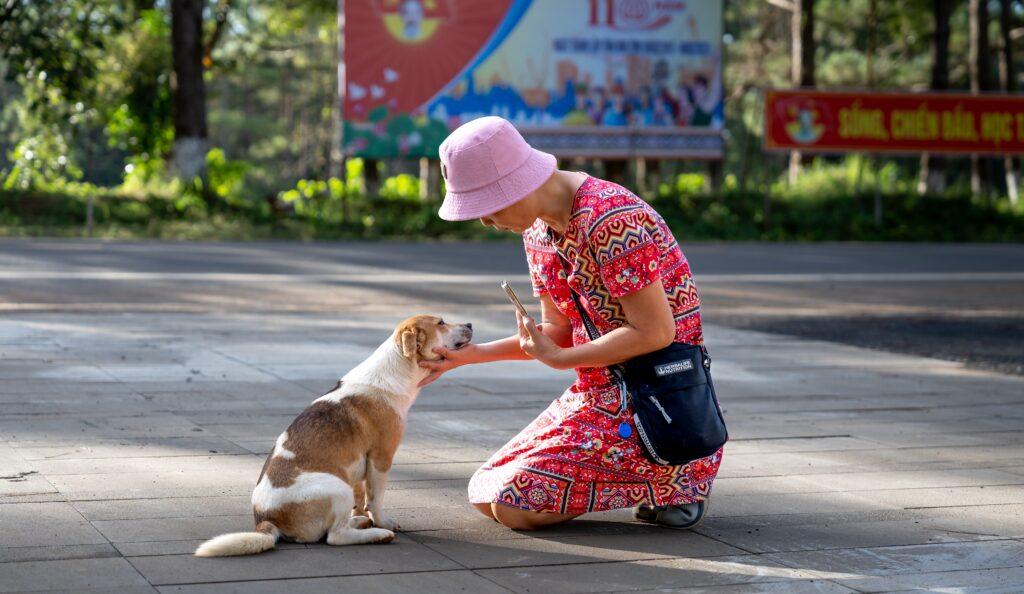
A major deal—for everyone—is introducing your significant other to the family. It’s quite different when you socialize your dog to your significant other. Regardless of how hostile your family may be against a new spouse, at least they won’t bite, right?
It’s been “the two of you” when you share your life with your dog prior to welcoming a new person. Your dog will be used to being the “top dog,” so when you bring home a significant other, he can feel displaced and not be happy about it.
You can do the following things to make the introductions go more smoothly:
There’s a good possibility you won’t have time to set up these “neutral ground” conversations if you’re throwing a party or hosting houseguests. Your visitors should be aware that they are entering your dog’s domain and that it can take the dog some time to get used to them. These folks are strangers to your dog, so you should introduce them to him the same way you would any stranger. These first socialize interaction must be watched over and conducted as calmly as possible.
You can introduce your dog to home guests in the following ways:
You must maintain command of the circumstance. Keep your dog on a leash if you know he will become aggressive against outsiders who invade his domain or if you are unsure of his reaction. Allow visitors to enter, and once they are inside, let your dog start the introduction.
Allow your dog to greet your guests while keeping him on a short leash. Allow your guests to give him a tiny present if you are confident that he will accept it well. This serves to further solidify the association between stranger and treatment. Give your dog a treat when he behaves well and is calm.
Use the commands “sit,” “down,” or “stay” if your dog has been taught them when guests arrive at your home.
You should greet visitors first so that your dog can observe your interactions. Your dog will detect the pleasant interaction, will notice that you’re relaxed, and that might encourage him to relax, whether you shake their hands or embrace them.
Inform your visitors if your dog jumps. Inform your visitors that if your dog jumps on them, they should turn their backs to the dog and place their arms across their chests. Ask them to refrain from addressing your dog by name or even from saying “down.” The fact that they are turning away will deter the dog from jumping because he is not being petted and is being ignored.
You could choose to let your dog off his leash once the visitors have entered your home and he seems at ease with them being there. Keep an eye on his level of tension and provide your visitors with advice on how to speak with him.
Extreme caution must be used whenever children are present, whether you are bringing a new baby home, hosting visitors with children, or running into kids on the street.
Children squeal, run around, and sometimes yank the dog’s fur or unintentionally step on its paws or tail. A youngster running around may in some cases and with some breeds trigger the dog’s predatory instinct, which can have catastrophic results. Avoid interacting with dogs you don’t know too much. If you have children and are adopting a dog for your family, do your research to make sure the dog is “kid friendly.”
Here are some pointers to socialize your dog to kids in a secure way:
You, the pet parent, must pay attention to your dog and his body language if you want to foster positive connections between your dog or puppy and visitors to your home, people you meet on the street, or if you’re bringing home a new, little human. When he feels at ease, move cautiously. When your dog shows signs of anxiety, you should go more slowly or remove him from the environment and try again later.
Dogs strive to win over their owners. They might take some time to warm up to a stranger, but with time and encouragement, your dog and the people in your life will develop a close friendship that will last a lifetime.
If you are interested in any of our products please check out our store page and if you would like to join our Facebook page click here.
After they poop, dogs will occasionally use their hind feet to scratch or kick the ground. Give them freedom to; we don’t know why they do it, but it seems they like it.
It’s a routine ritual. A dog urinates or defecates, then scuffs dirt, grass, or gravel into the air in what appears to be an accomplishment or at the very least, a mark of celebration. What motivates canines to behave in this way?
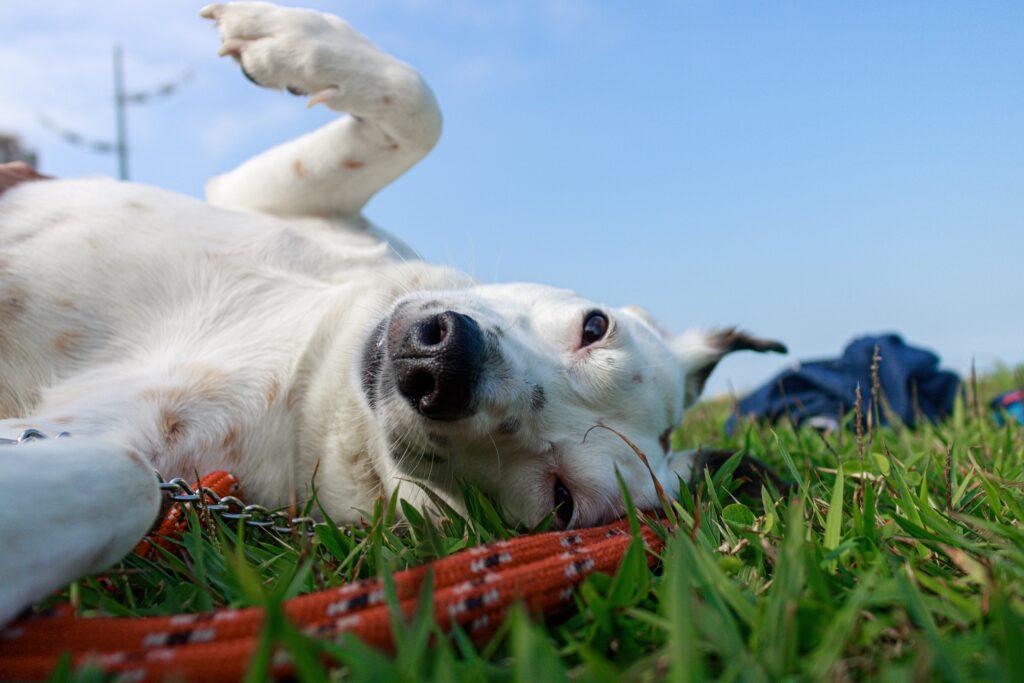
According to certain research, males engage in this behavior substantially more frequently than females when other dogs are present.
Dogs may do this for a variety of reasons, depending on the people present and what they are attempting to convey through visual, olfactory, and aural cues. He claims that dogs who exhibit this behavior appreciate it and that it appears to have significance for them.
If your dog’s grass kicking harms your yard or causes other issues, find entertaining diversionary strategies and encourage other habits until this one is under control. If not, wait until your dog has finished speaking before moving on with your walk. This will allow them to finish their message.
The Posh Dog Knee Brace is a 100% custom Dog knee brace, hand made only for your Dog. We make our custom brace with no casting. Our state-of-the-art brace for Dogs is very durable, waterproof, sand proof, and easily adjustable by customers.
If you are interested in a Posh Dog Knee Brace you can contact us on our contact page or you can order from our store. If you would like to check out our community page on Facebook click here.
We are used to reading that regular walking will keep your dog healthy. How frequently do you walk your dog though? How often should you do this? How much activity do dogs actually require? How can I make the most of a dog walk? Find all of those answers right here!
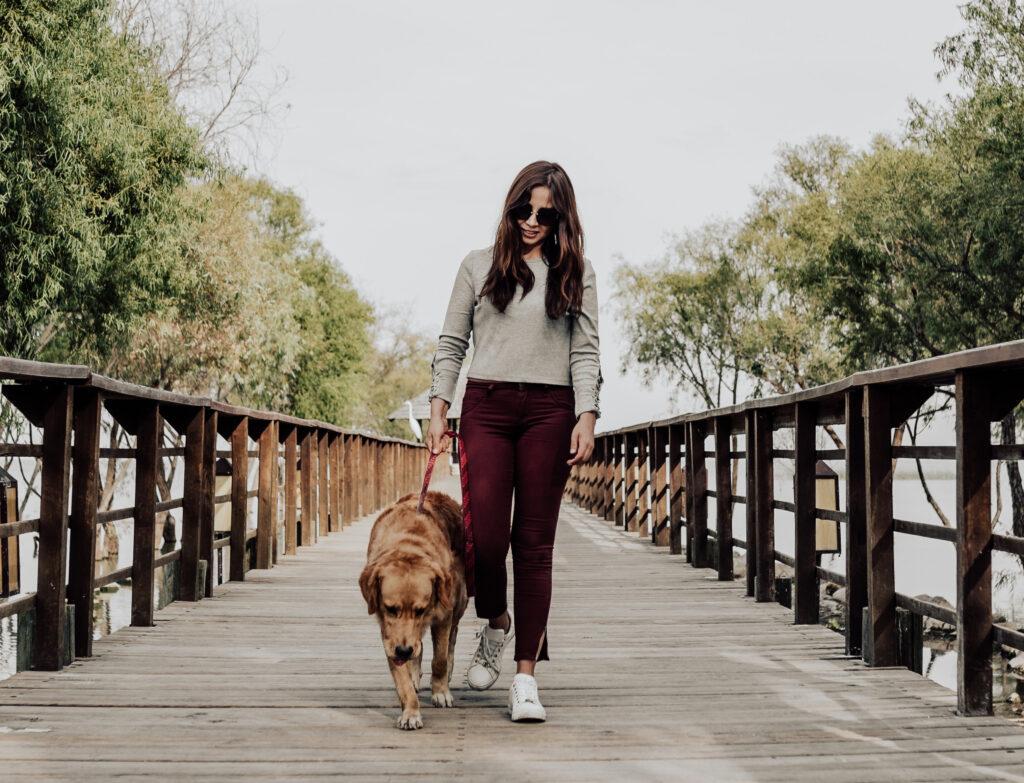
It’s generally advised to take your dog on a walk for at least 15 minutes three to four times every day. However, this may change depending on your dogs:
Smaller dogs might benefit from just one daily stroll, but high-energy dog types will need multiple walks. Is one of those breeds your dog? Are you an active person who wishes to spend more time exercising with your dog? Perhaps you are unsure of the precise amount of exercise your dog need. A trip to the vet is advised in that situation. They will be pleased to offer you practical hints and walking guidance tailored to the particular conditions involving your dog.
Every dog belongs to a distinct breed group, and every breed has unique exercise requirements and restrictions. Giving you a good idea of how much activity to aim for, it’s simple to stay on track after your daily goal has been established.
The amount of sleep your dog receives is as crucial to how much walking you should undertake. After all, a full day of action calls for a restful sleep. Learn your dog’s sleeping patterns, check to make sure they’re getting enough (quality) sleep, and determine if anything seems off. For instance, excessive sleeping could be a warning that you should consult your veterinarian.
If you’re a really active person, these high-energy breeds will fit your lifestyle:
Outdoor activities are the ideal method to develop a relationship with these animals. Your dog will make the trip more enjoyable whether you choose to stroll, hike, or run.
These dog breeds require more exercise than others:
If your dog falls into one of these categories, aim to push them beyond their physical limits while also testing their training and cognitive abilities. The dogs in these categories will find ordinary games dull, so feel free to get inventive!
Did you realize? These dogs need a minimum of 2.5 hours of intense activity per day.
This can readily be translated into at least four daily walks of 20–25 minutes each. Due to their high intelligence, dogs in this category should also be given mental challenges. A minimum of 30 minutes should be set up each day for intelligence game sessions with them. Make sure to outfit these puppies with an activity monitor so you can follow them on all of their outside escapades.
Terrier dogs come out as little, vivacious, strong-willed, and trainable. Although there are only a few dogs in this pack, they nevertheless require a lot of exercise.
Advice: Terriers require at least 1.5 hours of exercise each day.
A reasonable walking routine might involve three 20–25 minute walks each day. For this group, you might want to add some games that need cerebral exercise. It should be difficult enough for 20 minutes a day to keep them active.
Breeds belonging to this group, such as:
Definitely need a challenge in the activities. For them, a minimal amount of daily walking and exercise is one and a half hours. Since these dog breeds enjoy running as well, feel free to begin a running exercise with them as long as you take your time and account for your dog’s age.
It’s important to remember that dogs in this group should take at least three daily walks of at least 30 minutes each, in addition to engaging in cognitive activities.
Chihuahuas and other small dog breeds are typically what we refer to as companion animals today. Avoid subjecting these low-energy breeds to long periods of strenuous activity. Instead, allocate shorter amounts of time for enjoyable activities like games and regular strolls to keep the kids active.
Overly active dogs, such as those with short hair, can have detrimental effects. Since they have less fur, they are more prone to respiratory problems and easy overheating. Take these breeds on quick, uncomplicated strolls. Activity monitor your dog to keep tabs on your tiny dog’s daily exercise to make sure it doesn’t exceed recommended levels.
Watch out: These dog breeds only need two daily, brief walks.
There are several benefits for your dog in frequently walking with you. Some of these explanations have to do with your dog’s health, while others have to do with its training. While following you and moving at your pace while on a leash, your dog might learn discipline.
Are there any considerations you should make when walking your dog? Safety comes first as usual.
Only when you are confident your dog won’t run away and you are in a safe, unpopulated place should you try off-leash dog walks.
Don’t punish your dog if they do manage to escape. Your dog must not identify your return with any sense of wrongdoing or resentment. Keep your dog on a leash at all times if you find that they have a tendency to run away. Make sure to teach your dog the fundamental safety commands as another safety advice. They are not only simple to teach, but they can shield you and your animal companion from risky circumstances.
A dog parent’s life includes taking their dog for walks frequently. A short stroll helps your dog behave better in social situations and strengthens the connection you share with your dog. You may have fun while working to keep your dog healthy if you view dog walks as enjoyable times of the day.
Another way to lessen destructive chewing or scratching is to take your dog for a walk (should this be an issue your dog is facing).
However, the advantages extend beyond your dog! In fact, going outside to spend time with your dog can improve your general wellbeing and level of fitness. Daily walks can reduce your risk of developing diabetes, strengthen your bones, and lower your blood pressure. So, why are you still waiting? Get your dog outside and walking!
For more information you can reach us on our contact page or visit our Facebook page for more tips.
Read reviews check out our Google Reviews online. Click Here